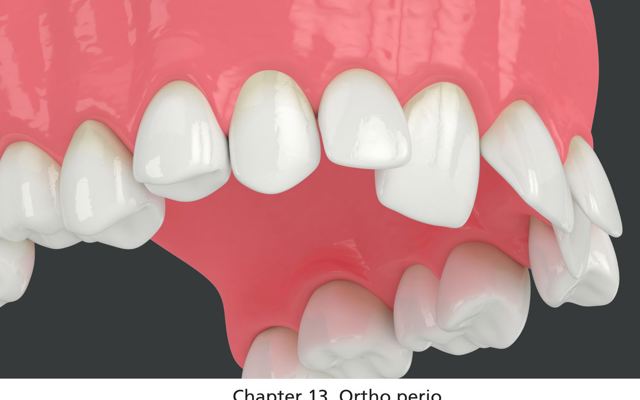Orthodontics and Periodontal Health
Orthodontics and Periodontal Health
Gum disease (periodontitis) is caused by the build-up of bacterial plaque on the teeth. Misaligned or crooked teeth can be difficult to clean properly, which may place you at a higher risk of developing gum disease. Severe gum disease can also cause tooth movement; you may notice spaces opening between your teeth, or your teeth flaring out towards your lips, tipping or dropping down (Figure 13). Orthodontic treatment with braces or clear aligners can be used to straighten the teeth, improving their appearance and your oral health.
Your dentist or periodontist may recommend straightening your teeth to make them easier to clean or correct the bite.

Can I have orthodontic treatment if I have gum disease?
If you have active gum disease, orthodontic movement can be dangerous because it can accelerate irreversible destruction of the gum and bone around the teeth and increases the risk of tooth loss[1]. Periodontitis most commonly affects adults, and often presents with few symptoms. Since more adults are now seeking orthodontic treatment than ever before, make sure that you first see your dentist or periodontist to
ensure your gums are healthy. In most cases, you can safely undergo orthodontic treatment after periodontal treatment, if you clean your teeth carefully[2]. In recent years, ‘mail-order’ orthodontic aligners are becoming available, but your treatment may not be properly supervised by a clinician. It is recommended that you check your gums are healthy before starting and that you seek orthodontic treatment with a specialist orthodontist instead. Often orthodontic treatment requires a high level of expertise and experience. Maintenance of gum health, good oral hygiene and frequent recall are vital during treatment.
Can orthodontic treatment cause gum recession?
Moving teeth with braces or aligners (along with many other factors) can make them vulnerable to gum recession[3]. Gum recession is when the gum pulls back, exposing the sensitive root surface and making the tooth appear longer. While not all recession requires treatment, periodontists can assess the gum tissues before, during and after orthodontic treatment. In some cases, we offer gum grafting to cover the exposed root surfaces or thicken thin, fragile gum tissues, helping to reduce the risk of further recession. Recession is best caught early, so if you notice any changes, mention these to your dentist or orthodontist as soon as possible.
[1] Ericsson et al. 1977; Melsen,1986; Wennström et al. 1993
[2] Pini Prato and Chambrone, 2020
[3] Jepsen et al. 2018
